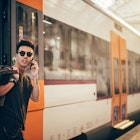
“It feels like exploring before the Vikings": Iceland prepares for a return to tourism

Nov 13, 2020 • 4 min read

Myvatn Nature Baths © Carlos M. Almagro/500px
Elena Gonzalez, a nurse at a critical care unit in Spain, left her overcrowded hospital for a long-due vacation this fall, searching for a destination relatively free of Covid-19. In Iceland, she observed, the term "hot spot" just referred to the volcanoes.
- placement: fullWidth
- path: articles/in-content-top
- possible size: [970, 250], [970, 90], [728, 90], [300, 250], [320, 50], [1, 1],
- targeting:
{ "url": "visiting-iceland-after-covid", "destination": "Iceland", "continent": "Europe", "country": "Iceland" }
So far, she has walked behind Seljalandsfoss, watched icebergs drift towards sea at the Glacier Lagoon, and dipped her toes into the water-filled Grjótagjá cave. “My photographs literally have no people,” Gonzalez, 26, told the Lonely Planet. “It feels like exploring Iceland before the island was settled, before the Vikings."
Nowadays, the hot springs and waterfalls and lava fields all have massive parking lots on the side. They’re empty, but for how long? With one of the largest wilderness areas in Europe, Iceland is expecting a greater appreciation of its remote and desolate land once international travel resumes. The two-meter distancing rule can just as well be two kilometers.

“Judging from online traffic and internet searches, there are a lot of people daydreaming about Iceland right now,” says Kristjan Sigurjonsson, an industry expert who edits Turisti.is. “Over the years, Iceland has been popular among young people -- the group most likely to take off once restrictions ease.”
For now, though, getting into Iceland is a mission. All incoming passengers need to quarantine for five days after arrival and then get coronavirus tested. That means tourists have to self-isolate in Reykjavík before embarking on their planned trip (and risk further isolation in case the test is positive).
Summer 2021 in Iceland
Visitor numbers are expected to remain relatively low next summer, making it an ideal time to promote epic road trips. The Arctic Coast Way, a 900 km (560 mile) connecting 21 harbor villages and under-appreciated northern attractions, has emerged as an exciting alternative to the famous Ring Road.
- placement: fullWidth
- path: articles/in-content-middle
- possible size: [970, 250], [970, 90], [728, 90], [300, 250], [320, 50], [1, 1],
- targeting:
{ "url": "visiting-iceland-after-covid", "destination": "Iceland", "continent": "Europe", "country": "Iceland" }
Improved road conditions in the Westfjords, including a recently-opened six-km (four-mile) mountain tunnel, is also making the unbeaten path more accessible. A stunning fjord-zigzag, the Westfjords Way, can easily sustain an entire vacation.
In November the government announced plans to open a large public park in the Westfjord area of Dynjandi waterfall and legislators are already moving ahead with plans to turn the entire Highland region into a park. This will allow greater control in overcrowded places, protecting the environment people come to see.
The harbor town of Húsavík has become more popular, being the fictional hometown of the characters in the 2020 Netflix comedy 'Eurovision Song Contest: The Story of Fire Saga.' The town is otherwise known as the whale-watching capital of Iceland - some say Europe - and tour operator Heimir Hardarson believes the area will benefit from the forecasted trend of people making fewer-but-longer trips abroad.

“Back at the height of the tourism boom, when the airlines were competing for scale, people were visiting Iceland on a trans-Atlantic layover for maybe four days,” he said. “That’s not enough time to make it up north. So our growth has been much more gradual and organic.” He estimates that as people embrace “slow travel” they will inevitably consider more the environmental impact of their actions.
- placement: native
- path: articles/in-content-native
- possible size: [f, l],
- targeting:
{ "url": "visiting-iceland-after-covid", "destination": "Iceland", "continent": "Europe", "country": "Iceland" }
And as travelers make their way around the island -- slow or fast -- investors figured they all need one thing: a bath. Geothermally-heated baths have opened up in all corners of the country. The latest is Vök Baths in east Iceland. Reykjavík is expected to get its first next year with the opening of Sky Lagoon.
Airlines are also preparing for the return of tourists. Icelandair, the flag carrier, recently announced an ambitious schedule for next year with regular flights between 32 destinations in Europe and North America. Other airlines, such as American Airlines and Delta, are also preparing for demand to rise next year.
Wary of welcoming tourists too soon, the government is expected to maintain the double-testing requirement throughout December. In August, three visitors from France violating their mandatory five-day quarantine upon arrival visited a crowded pub in downtown Reykjavik, infecting dozens of people and putting the capital on lockdown for weeks.

Being a country that thrives on foreign visitors, the government has instead invited foreign nationals outside of Europe to get a long-term visa that allows them and their families to stay in Iceland for up to six months. The offer, however, only extends to those with at least US$7000 in monthly earnings.
On a recent freezing cold but sunny afternoon by Lake Mývatn, five international students from the University of Iceland were eating sandwiches next to an out-of-business café. “We have to attend classes remotely,” said Moara Smets, a student of linguistics, “and that is precisely what we are doing. Very very remotely.”
You might also like:
Why the Westfjords are place to escape the crowds in Iceland
Iceland's 10 best natural wonders
Iceland's best road trips
- placement: fullWidth
- path: articles/bottom
- possible size: [970, 250], [970, 90], [728, 90], [300, 250], [320, 50], [1, 1],
- targeting:
{ "url": "visiting-iceland-after-covid", "destination": "Iceland", "continent": "Europe", "country": "Iceland" }
Explore related stories


 Sustainable TravelThe “world’s longest bus trip” covers 22 countries in 56 days. Think you could handle it?
Sustainable TravelThe “world’s longest bus trip” covers 22 countries in 56 days. Think you could handle it?Mar 29, 2023 • 4 min read


 Sustainable TravelTraveling by train in Europe this summer? Here’s 7 things you need to know
Sustainable TravelTraveling by train in Europe this summer? Here’s 7 things you need to knowMay 6, 2022 • 5 min read




